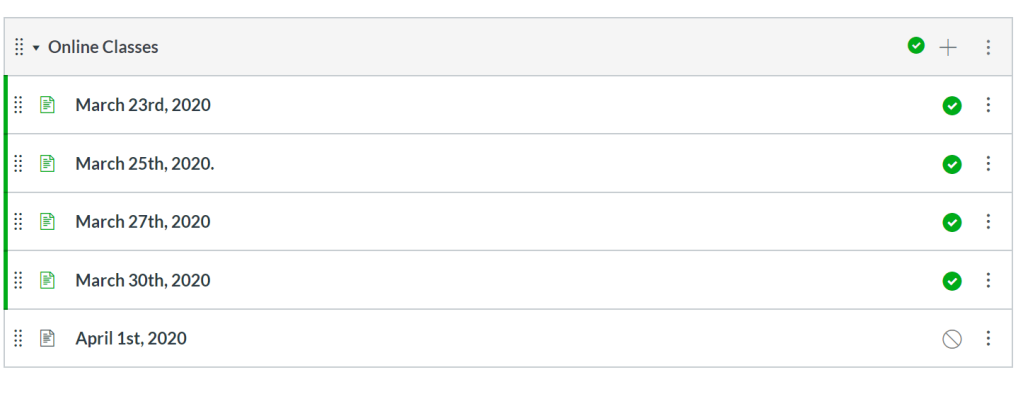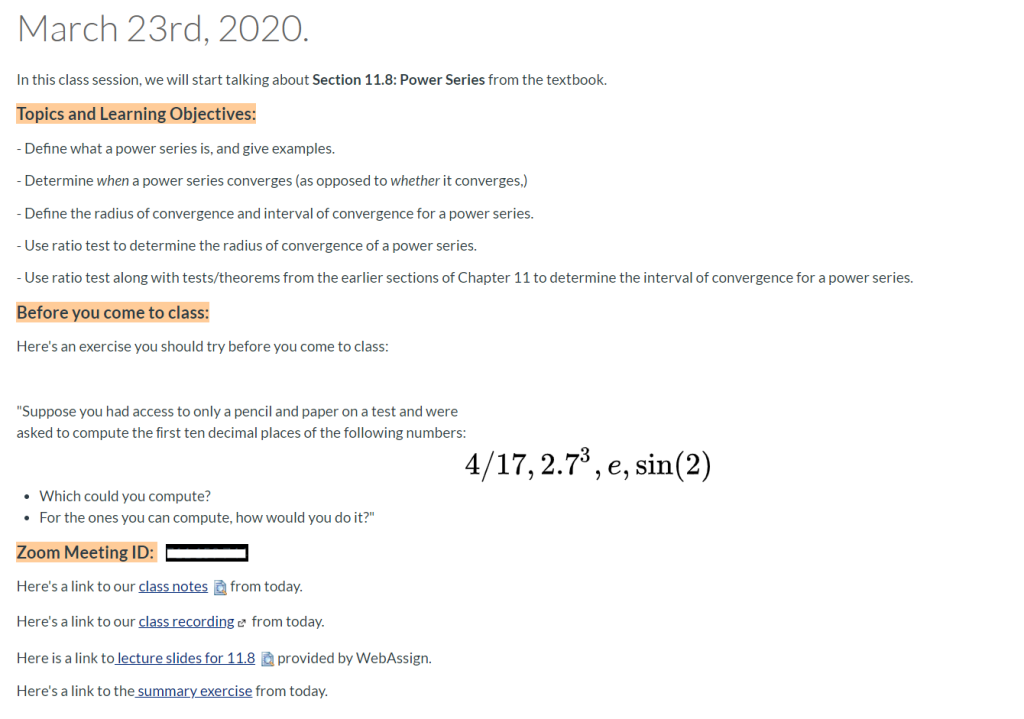“I have never worked longer hours than I did when we switched to online in the middle of last semester.”
“…there is always something to grade, and I’m able to access it any time, I feel like I have to stay on top of it.”
“One thing that is not very clear to me is how to keep up with all the new comments/questions added to asynchronous discussions…”
“It sounds like we should constantly be on the lookout for new information, and that sounds a bit overwhelming.”
These are all examples of things I’ve been hearing from colleagues assigned the arduous task of teaching online in the Fall. I’ve had a few ideas regarding this concern floating around in my head since my online teaching fellowship in June. (If you have no clue what I am talking about, I explain the fellowship a bit here.) This came up multiple times during my fellowship, not the least because faculty enrolled in that course brought it up as a concern for teaching in the Fall. It also came up because I was a graduate student and a facilitator for a course that enrolled faculty members from my own department. The role-reversal was unusual, to say the least. Luckily, everyone in my department was incredibly supportive and respectful. They let me lead the live sessions without derailing the conversation or putting me in a position where I’d have to choose between awkwardly admonishing them or not doing my job well.
Still, the three-week course was an exercise in setting boundaries and expectations, especially over email. I quickly realized that spending a lot of time thoughtfully constructing an answer to every email as soon as it arrived, or attempting to personally solve every problem brought to my attention, just wasn’t feasible. I also couldn’t possibly entertain requests to meet over Zoom on a Friday evening and keep my sanity. Instead, I learned to delegate, answer emails in bulk, and refer people to resources available online instead of researching how to solve their very particular technology issues myself. This was not easy, since I genuinely like everyone in my department, and I’m conditioned to “be helpful” as much as possible. I also believe this is one of the most important things I learned through the fellowship.
Many of the strategies I learned can be translated into setting boundaries in an undergraduate course taught online. Thus, I thought it might help Future Maryam to have a list of ideas, both ones I have used, and ones I have read about in one place to refer back to as needed. I hope it helps some of you as well!
- Set up work hours. This first one is hopefully relatively obvious. Just because you’re “working from home” and you “live at home” doesn’t mean that regular work hours go out the window. Even if you are the type of person who works better in the evenings, like I am, just because you are working at 7 pm doesn’t mean you’re available for a 7 pm meeting.
- Only answer emails during work hours. This is a continuation of the previous point. If you respond to emails at 10 am and at 8 pm, people will start to expect a response at every hour of the day. This is especially true if you answer every email within 10 minutes of it being received. Don’t do this. Set aside a time during regular work hours to respond to emails.
- Make use of schedule-send. Both Outlook and Gmail now have this feature where you can schedule an email to be sent out at a specific time. If you are working at 7 pm and you receive an email that does not require an immediate response (hint: 95% of them don’t), but it would only take a couple minutes to write one, and you’d rather just get it over with, go for it! Write a response, and then schedule it to be sent out at 9 am. This way, it is out of your head, but it doesn’t give the impression that you are available 24/7.
- Get a Google Voice number. I’ve only recently gotten a google voice number, and while I haven’t used it for this purpose yet, I’m definitely intrigued by it. It seems like a suitable replacement for a “work phone” if that’s a luxury you were used to in pre-pandemic times. I never had a work phone, but I wonder if it would still be useful for your students to have more than one way of contacting you.
- Respond to things in one go. Set aside a time to respond to all emails from the past day in one go. I try to do this right after breakfast, at the top of my workday, though you could also do it at the end. If you’re assigning weekly asynchronous discussions, for example, set aside a time one a particular day of the week to go through them and respond to the ones that require a response. This way, you don’t have to constantly be on the lookout for new information.
- Set up an expectation beforehand for when you’d be available and responding to asynchronous content. For example, suppose you assign weekly posts and responses in a Discussion Forum, where the first post is due on Thursdays. You could let your students know in advance that you will read and respond to their posts on Friday. You could then set another deadline for them to respond to each other or you. In my hypothetical example, this deadline might be Sunday.
- For email, I have seen people add something along the lines of “I will respond to your emails within 24-48 hours, except on the weekends.” to their syllabi. I think this is a good idea. This way, your students don’t have to struggle to decide how long it is appropriate to wait before sending a reminder email.
- You could also set up an automatic reply to your email: “Hello! If you are a student in my [class name/number] class, please note that I do not check email between [this hour] and [this hour]. Please refer to the FAQs to see if your question has already been answered. If this is an absolute emergency, contact me at [alternative way to contact]” See below for more on FAQs, and note that a Google Voice number might be a good alternative contact method.
- Don’t respond to every single post. Going back to the discussion post example: don’t feel like you have to reply to every post. Respond where it feels natural, on posts that require a response—quality over quantity!
- Get students to respond to each other. There are many wrong ways of doing this, so tread lightly and carefully. Still, if you make it part of the assignment for students to respond to others’ posts, it takes off some expectation from your shoulders and fosters student-student interaction. This is especially helpful in a Q&A type discussion post, where students can ask questions, and other students can help answer. You could assign “bonus points” for solving a peer’s problem, for example.
- On that note, create an FAQ document and a Q&A discussion board. Instead of five different students emailing you the same question at seven different times of the semester.. wait, that will still happen. The point is that it is easier to link to an item in an FAQ document instead of answering it seven times. On that note, see if you can create a document with embedded links to each question for easier access to each item.
- The one thing that I dislike about the Canvas Discussion Forum is that you cannot tag users. Get students to type @YourName before a response that they’d like you to see and answer anyway. Then on your assigned day of the week, go through and answer the stuff that explicitly has you tagged first (you can search entries by using CTRL+F or the in-built search functions on Canvas.)
- If you’re teaching a large enrollment class, consider creating a separate email address for your class. I’ve also seen professors ask students to put “[Course Number]–[Course Title]–[optional: Section Number]” in the subject line. This especially helps if you’re teaching more than one Section or course.
- Last but not least: if this is your very first time teaching a course online (Spring 2020 doesn’t count), don’t overcomplicate it. It is deceptively easy to go down the technology rabbit hole and start buying into this myth that the more fancy tech you use, the more impressive your course would be. This is simply false. Remember, if you are overwhelmed — your students will be too!
I hope these help, and please let me know if you have any other ideas or if you disagree with some of mine! Until next time.

